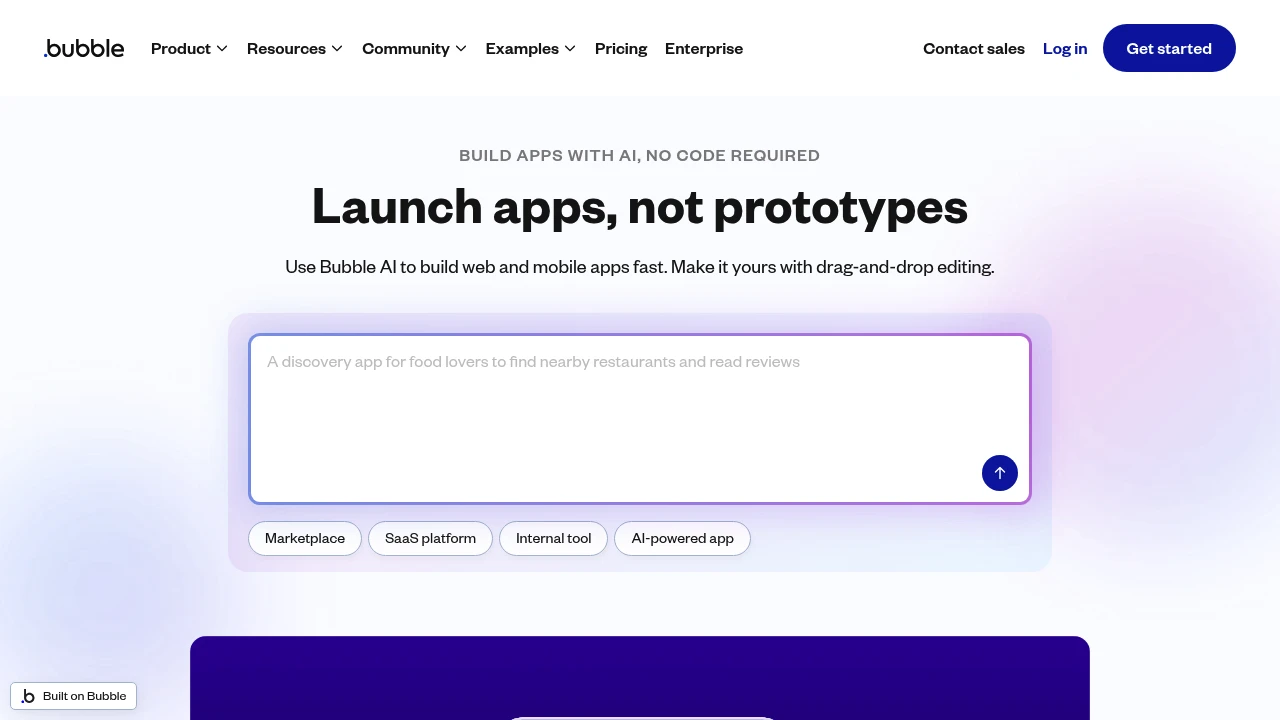Bubble
Bubble lets you design, launch, and scale full web apps—now with AI assist for workflows and copy.

Bubble Features & Overview
Bubble is a visual web app platform for founders, operators, and teams. You design pages with a pixel-precise editor, define workflows for logic, and model data with privacy rules. The system compiles these pieces into a running application with authentication, responsive layout, and a production database. You connect external services through the API Connector or install plugins from a large marketplace. Payments, email, maps, and AI endpoints plug in with guided configuration. Deploy with a staging workflow, attach a custom domain, review logs and metrics, and add capacity as traffic grows.
Core Features
- Visual editor and components: Drag elements, set constraints, and manage responsive rules down to breakpoints and min widths. The editor writes structure that stays consistent across pages and supports reusable components for faster iteration.
- Workflow engine for logic: Define event-driven workflows that handle form submissions, conditionals, and background jobs. You chain actions like create records, call APIs, and route users, and you control execution with clear success and failure paths.
- Data modeling and privacy rules: Create data types, fields, and relationships in a built-in database. Privacy rules restrict read and write access by role and condition, which protects sensitive records without custom ACL code.
- Authentication and user accounts: Enable email and OAuth sign-in, password reset, and session handling. Protected routes and role checks keep private pages locked while keeping signup and onboarding straightforward.
- API Connector and webhooks: Connect REST APIs with custom headers, params, and OAuth 2.0. Define calls once, reuse them across workflows, and receive webhooks to trigger actions from external systems.
- Plugin marketplace: Install community and partner plugins for payments, email, search, analytics, and AI. Each plugin exposes actions and elements that drop into workflows and pages so integrations require less wiring.
- Payments and subscriptions: Add one-time charges, plans, and invoices with providers like Stripe. Webhook handlers update subscription state and retries while UI components display pricing, receipts, and status.
- Backend workflows and scheduling: Run tasks on the server with scheduled and recurring jobs. Queue batch operations, send emails, and process webhooks without blocking the page runtime.
- Responsive layout system: Control grids, flex behavior, and container queries from the designer. Preview breakpoints, test common devices, and fix layout shifts before release.
- Versioning and staging deploys: Work in development, create a staging checkpoint, then promote to production. The deployment view lists changes and helps roll back quickly if a release causes regressions.
- Monitoring and analytics hooks: Inspect server logs, workflow timings, and API responses in one dashboard. Emit events to analytics tools so product teams track funnels and performance with real data.
- Security and compliance settings: Enforce SSL, content security policies, and rate limits. Enterprise controls add SSO, audit logs, and advanced permissions so larger teams keep governance tight.
Supported Platforms / Integrations
- Web editor and hosted runtime
- API Connector for REST and OAuth 2.0
- Stripe and common payment providers
- Email services such as SendGrid
- Popular auth providers with OAuth
- Plugin marketplace for maps, search, analytics, and AI
Use Cases & Applications
- Founders launching MVPs, paid betas, and subscription apps
- Operators building internal tools and partner portals
- Agencies delivering marketing sites and transactional microsites
- Educators and communities running directories, marketplaces, and cohorts
Pricing
- Free
- Starter: contact sales
- Growth: contact sales
- Team: contact sales
- Enterprise: contact sales
Why You’d Love It
- Designs, data, and logic live in one build workflow
- Plugins and APIs cover most integrations without custom code
- Staging to production deploys keep releases safe and quick
Pros & Cons
Pros
- Fast visual iteration with event-driven workflows
- Built-in database, auth, and hosting reduce setup time
- API Connector and plugins unlock common integrations
Cons
- Heavy traffic and complex logic can require careful optimization
- Custom code extensions need plugin work or external services
Conclusion Bubble gives non-developers and lean teams a clear path to production software. You compose UI, workflows, and data, connect services, and ship on hosted infrastructure. As traction grows, you add capacity, refine rules, and keep iterating without rebuilding your stack.